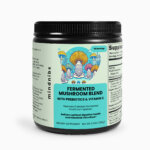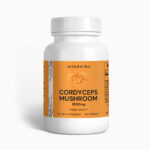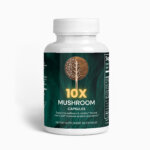
“Mushroom Identification: What Does Lion’s Mane Look Like?”
Imagine yourself wandering through the forest, the ground spongy with moss beneath your feet, the air lightly seasoned by nature’s tranquility. Ahead, nestled amidst the lattice of a venerable oak, a curious spectacle catches your gaze. It’s shaggy, it’s pearly white, and it looks like something straight from a fantastical woodland realm. You’ve stumbled upon the whimsical world of fungi, and sitting there like a regal creature clad in a snowy robe is the lion’s mane mushroom.
This cottony wonder is not only a delight for the eyes but a treasure trove of culinary and medicinal prowess. Yet, for those uninitiated in the art of mycology, the sight of a lion’s mane mushroom in the wild raises a bounty of questions. What should you look for to distinguish it from its fungal brethren? How can you be certain you’re beholding a true lion’s mane and not some deceitful doppelgänger?
Fret not, dear forager and enthusiast, for you’re about to embark on a journey into the heart of mushroom identification. We will weave through the details, textures, habitats, and subtleties that define the majestic lion’s mane. By the end of this exploration, you’ll not only know what lion’s mane looks like but also how to spot it with the confidence of a seasoned mycologist. So, sharpen your senses and let your curiosity roam free—it’s time to uncover the secrets of identifying the enigmatic lion’s mane mushroom.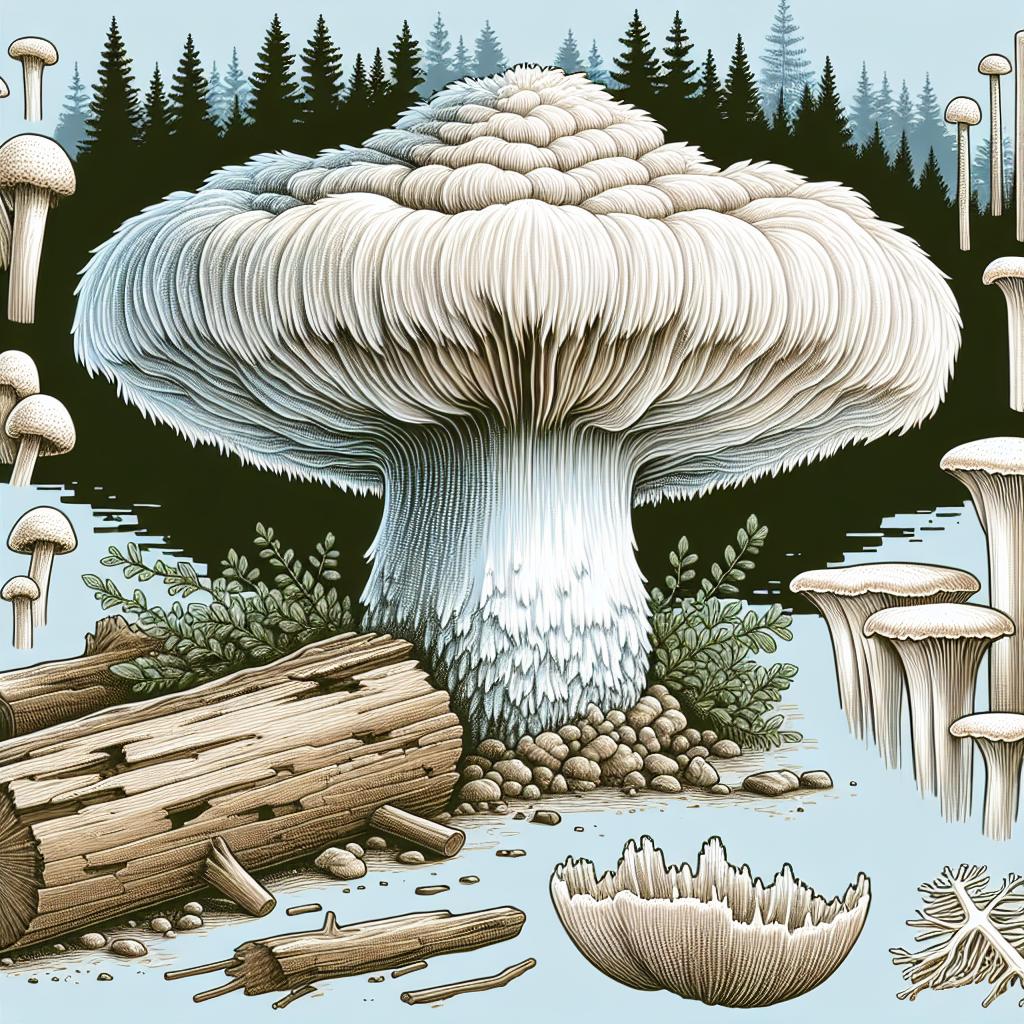
Table of Contents
- Unveiling the Mysteries of Lion’s Mane Mushroom Identification
- Spotting the Hallmarks of Hericium Erinaceus in the Wild
- Decoding the Habitat: Where to Find Lion’s Mane Mushrooms
- Recognizing the Unique Spore Print of Lion’s Mane Mushroom
- Distinguishing Features: Texture and Growth Patterns
- The Importance of Seasonality in Searching for Lion’s Mane
- Safety First: Differentiating Edible Lion’s Mane from Lookalikes
- How to Harvest Lion’s Mane Without Harming the Ecosystem
- Preserving Your Foraging Bounty: Proper Storage of Lion’s Mane Mushrooms
- Transforming Your Finds: Delicious Lion’s Mane Mushroom Recipes
- Q&A
- Final Thoughts
Unveiling the Mysteries of Lion’s Mane Mushroom Identification
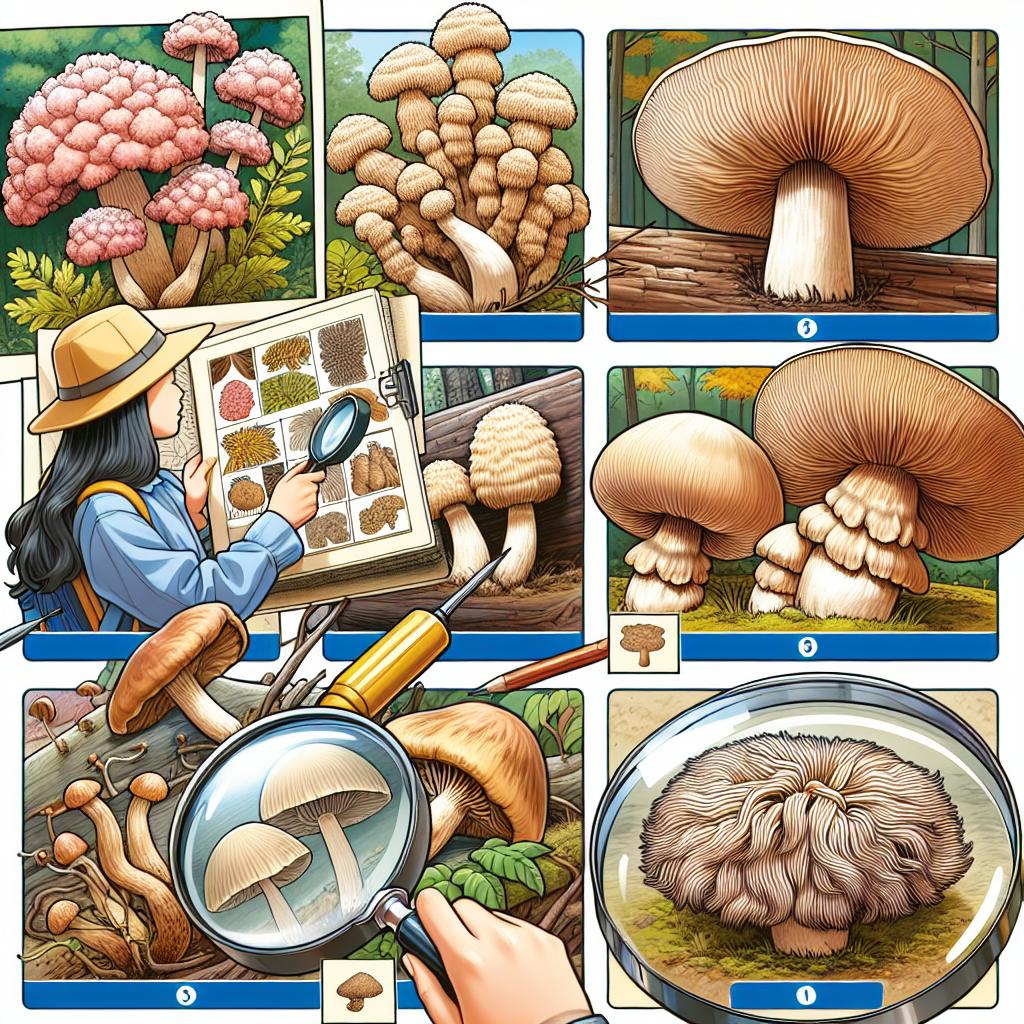
Embark on a foraging adventure, and you may just stumble upon the woodlands’ culinary crown jewel: the Lion’s Mane mushroom. Hericeum erinaceus, its formal moniker, conjures images of a royal creature, and rightly so. This unique fungus boasts a shaggy appearance, reminiscent of a white mane, gracing the branches of hardwood trees. Picture a miniature waterfall of icicles or a pom-pom plucked from nature’s craft store, hanging elegantly on aged wood.
Sight isn’t the only sense ensnared in this quest; texture is equally telling. Run your fingers through its cascading spindles, and feel the soft, tooth-like structures. Unlike the gilled faces of common mushrooms, Lion’s Mane bestows a tactile curiosity, inviting a gentle touch that confirms its identity. Dare to discern its exquisite form, and your fingertips will thank you for the delicate encounter.
Now, let us confer about color; a Lion’s Mane mushroom parades a coat of pristine white when young, which wades into a golden yellow as it matures. The hue shift is subtle, yet significant in signaling the optimal time for harvest. Keep an eye on these chromatic cues:
- Fresh Young: Bright, brilliant white – an alluring beacon signifying tender, choice edibility.
- Maturing Grace: A tinge of cream to light yellow, suggesting a deeper flavor profile.
For those who cherish categorical clarity, here’s a quick-glance guide, styled in WordPress chic:
| Feature | Description |
|---|---|
| Appearance | Toothed, cascading spines resembling a white or yellowish mane |
| Texture | Soft to the touch with a spongy composition |
| Color | White in youth, aging to a cream or light yellow |
| Location | Gracing the wood of dying or dead hardwood trees |
Armed with this knowledge, the forest transforms into a trove of edible treasures, with the Lion’s Mane as your prized quarry. Let the thrill of the hunt guide you, and may your foraging yield a basket brimming with this delectable delicacy.
Spotting the Hallmarks of Hericium Erinaceus in the Wild

Amidst the forest’s medley of fungal forms, Hericium erinaceus, commonly known as the Lion’s Mane mushroom, stands out with an air of whimsy and wonder. Unlike the classic cap-and-stem structure of many mushrooms, this species features cascading spines reminiscent of a waterfall or a lion’s luxuriant mane. To the forager’s trained eye, these unique characteristics are a beacon in the woods, hinting at the presence of this sought-after delicacy.
Picture the scene: you’re wandering through a deciduous forest, the air is moist and the understory is dappled with sunlight and shadow. You’re on the lookout for a particular arboreal inhabitant – a creamy white clump with icicle-like tendrils that seem to glow against the rough brown texture of aging tree trunks. This mushroom prefers the company of hardwoods, especially the wounded or the wise, those veteran trees that have tales to tell. Spy a freshly fruited body clinging to a fallen oak or beech, and you might just have found your prize.
| Color: | Pale to Pure White |
| Shape: | Pom-Pom or Globe-like |
| Texture: | Shaggy, Spine-covered |
| Size: | Typically 5-40cm in Diameter |
| Habitat: | Hardwood Trees, Living or Dead |
Among the telltale signs of Lion’s Mane is the lack of a visible spore-producing surface; the spines themselves release the spores. Distinguishing this mushroom from its doppelgangers involves a sensory experience. Reach out and feel the difference as your fingers graze the slinky, soft spines. Unlike other mushroom flesh, it does not bruise or change color upon being touched, preserving its ethereal beauty even as you inspect it closely.
Using your senses is key, not just in identifying, but in situating yourself in the environment where Lion’s Mane thrives. As you forage, you become attuned to the gentle rustling of leaves, the rich scent of humus, and the sight of enigmatic fungi dotting the forest palette. The hunt for Hericium erinaceus is more than a quest for a gourmet ingredient – it’s an intimate dance with nature’s intricate layers, where every discovery has a story and every forager becomes a part of the woodland narrative.
Decoding the Habitat: Where to Find Lion’s Mane Mushrooms
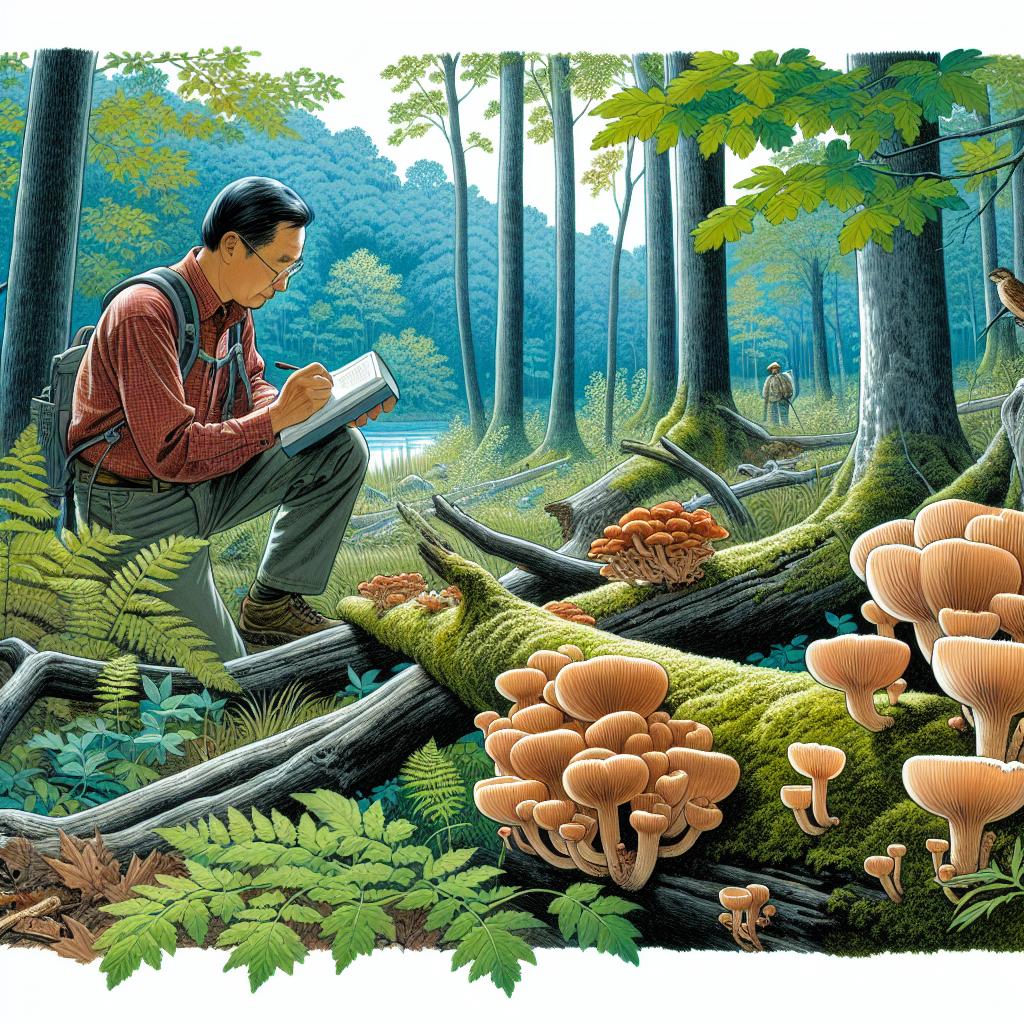
Embarking on a foraging adventure to find the elusive Lion’s Mane mushrooms can be akin to a treasure hunt in the great outdoors. These unique fungi have distinct growth habits, preferring to make their homes in the wounds of venerable trees. Be on the lookout for decaying hardwood trunks and stumps, as these are the preferred residences of these woodland gems. Mature forests, with their complex ecosystems, are often hotspots for biodiversity, making them ideal for spotting these bearded delicacies.
As the seasons change, so too does your window of opportunity to spot Lion’s Mane mushrooms in their natural setting. They grace us with their presence primarily in the late summer and fall months. However, in some climates where the conditions are just right, they have been known to grow throughout the winter months as well. Keep your eyes peeled for their cascading, waterfall-like spores during these prime mushroom foraging times.
- Aged hardwoods, such as maples and oaks – true palaces for these fungal wonders
- Stately beech trees – also formidable hosts, offering sturdy grounds for growth
- Wounded areas of the woods – where the heartwood is exposed, creating a haven for spores to cling and flourish
For those who prefer a visual guide, consider this succinct table that captures the prime locations for your foraging diary:
| Location Type | Common Trees | Season |
|---|---|---|
| Mature forests | Maple, Oak, Beech | Late summer to Winter |
| Decaying wood | Typically hardwoods | Fall and Winter |
| Injured trees | Where heartwood shows | All prime mushroom seasons |
Next time when the forest beckons you with its enigmatic allure, step in with a keen eye. Whether as a seasoned forager or a curious nature enthusiast, the hunt for Lion’s Mane mushrooms is not only a lesson in mycology but a respite from the clamor of daily life. Venture forth, connect with the earth, and you just may return with the prize of Lion’s Mane clutched in your grasp.
Recognizing the Unique Spore Print of Lion’s Mane Mushroom

Imagine embarking on a foraging endeavor, wandering through the verdant forests in search of the mystical Lion’s Mane Mushroom (Hericium erinaceus). This elusive fungi is sought after not only for its medicinal properties but also for its unique appearance. Unlike other mushrooms, its spore print—a key element in fungal identification—presents a captivating puzzle to the ardent mycophile.
Upon finding a suspected Lion’s Mane specimen, one might be tempted to marvel at its cascading, icicle-like spines. However, for those in the know, creating a spore print is the next thrilling step. You’ll need to detach a small section of these soft, toothy spines and place them on a dark background, as the spores tend to be a pale color. With bated breath, you wait, knowing that the spore print will soon reveal whether you’ve truly discovered this culinary treasure.
- Prepare a flat surface with both a white and a dark piece of paper to ensure spore visibility regardless of their hue.
- Position the fragment of the mushroom’s spine-covered underside onto the paper.
- Cover it with a glass to prevent air currents from disturbing the delicate process.
- Let the magic unfold over the next 24 hours as the spores are released to form a distinct pattern.
The spore print of the Lion’s Mane mushroom is a marvel to behold. It emerges as a fine, creamy white dust, arranging itself in a delicate constellation against the stark backdrop. This intricate pattern serves as a telltale fingerprint, indicating you’ve indeed found the fabled Lion’s Mane. Unlike bolder mushroom prints that are easily discernible, the Lion’s Mane’s spore print whispers its identity—a secret only nature enthusiasts truly understand.
Distinguishing Features: Texture and Growth Patterns

With a resemblance to its namesake’s magnificent mane, the Lion’s Mane mushroom is truly a wonder of the wilderness. The texture is one of the first signs you’ve stumbled upon this forest gem. Unlike the typical smooth cap and gills of other mushroom varieties, this species boasts cascading, icicle-like spines. Soft to the touch, these spines can grow quite long, adding to the mushroom’s distinctive shaggy appearance.
The growth patterns of the Lion’s Mane mushroom are equally distinctive. You’ll find these delightful fungi gracing the trunks of hardwood trees like a natural ornament. They prefer wounded or dying trees, where they emerge as solitary soldiers or in small, overlapping clusters. Seasonality plays a role too; the prime time to spot these beauties is late summer through fall, when the forest is a canvas of transformation.
- Spine Length: Ranging from 1 to 5cm, like little cascading waterfalls
- Color Palette: From a pristine snowy white to a more mature yellowish hue
- Preferred Trees: Oaks, walnuts, and beeches are among their favorites
| Feature | Description |
| Texture | Shaggy, spine-covered |
| Shape | Globular, cascading |
| Size | Can grow up to 40 cm across |
| Location | Found on hardwoods most often in temperate forests |
Engage your senses when you’re on a mushroom foraging quest, touch the softness, observe the telltale waterfall-like drapery, and embrace the subtle, almost sweet smell. With its standout features, the Lion’s Mane makes its presence known. Be it hanging like a sylvan chandelier or standing out like a beacon against the earthy backdrop, it’s much more than a forest dweller—it’s a forest highlight. Seek with curiosity, and the Lion’s Mane can turn an ordinary hike into a captivating treasure hunt.
The Importance of Seasonality in Searching for Lion’s Mane
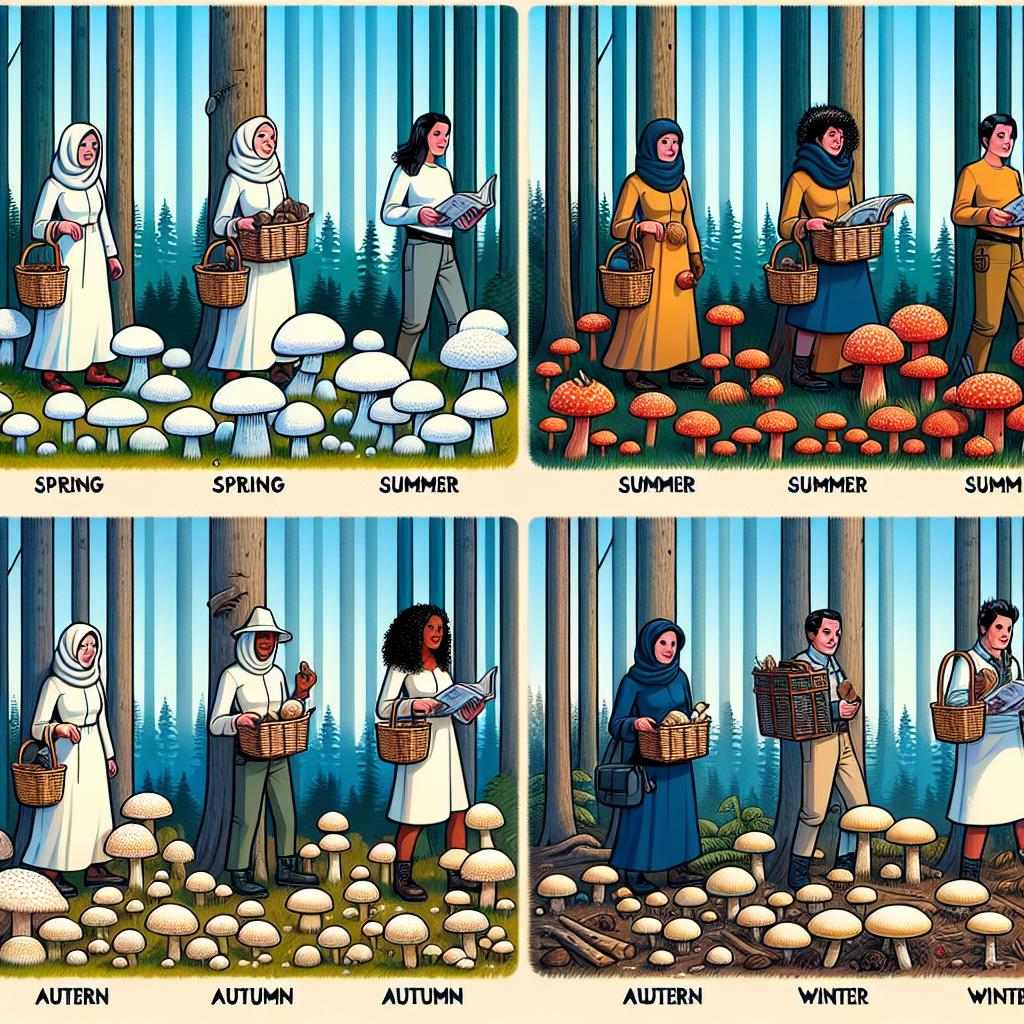
Unraveling the timing of your foray into the woods can make all the difference in successfully spotting the elusive Lion’s Mane mushroom. This unique fungi, with its flowing, white, icicle-like spines, isn’t a year-round find. Understanding when it’s in season will not only increase the likelihood of your discovery but also ensures you encounter them at their peak when their health benefits are most potent.
Nature’s calendar is precise, and the Lion’s Mane is a testament to this punctuality. Typically, fall through late winter is when these mushrooms adorn the trunks of hardwood trees in North America, although specific timings can vary based on your geographic location. To avoid returning empty-handed from your mushroom hunt, align your excursions with these optimal months.
- Life Cycle: Starts fruiting in late summer
- Prime Season: Peaks in fall
- Fading: Declines in late winter
During their peak season, Lion’s Mane mushrooms are also at their most nutritious. Containing a treasure trove of vitamins, minerals, and compounds like hericenones and erinacines, these fungi are sought after for their cognitive and neurological health benefits. Harvesting at the right time could mean reaping the full spectrum of their medicinal properties.
| Season | Availability | Quality |
|---|---|---|
| Summer | Emerging | Fresh |
| Fall | Abundant | Premium |
| Winter | Scarce | Varied |
For those passionate about foraging, being attuned to the rhythm of the earth is crucial. Not only does it serve the practical purpose of enhancing your chance at a bountiful harvest, but it also fosters a deeper connection with nature. Go beyond the mere visuals and engage with the ecosystem; timing is not just a detail, it’s the heart of the search.
Safety First: Differentiating Edible Lion’s Mane from Lookalikes

Ensuring you’ve correctly identified the Lion’s Mane mushroom, scientifically known as Hericium erinaceus, is crucial before considering consumption. Similar species like the Bear’s Head Tooth (Hericium americanum) could confuse both amateur and seasoned foragers. While both are edible, it’s essential to pinpoint the characteristics of true Lion’s Mane to enjoy its culinary and medicinal benefits safely.
Characteristics of True Lion’s Mane:
- Luxuriant, shaggy spines that can be over 1 inch long.
- A pristine white color when young, becoming beige as it matures.
- Grows on hardwood trees, particularly favoring wounded or dead portions.
- Typically found during the late summer through to fall.
Incorrectly identifying mushrooms can lead to unpleasant experiences or serious health risks. Thus, it’s worth noting the differences in the environment and spore coloration to avoid misidentification. Lion’s Mane leaves a white spore print, while similar species may leave a different hue. Also, its habitat predominantly includes North America and parts of Asia and Europe, which helps narrow the identification process based on your geographic location.
Let’s visualize the differences by examining a simple comparison table:
| Lion’s Mane (Hericium erinaceus) | Lookalikes |
|---|---|
| White, aging to beige | May exhibit varied colors like yellow or brown |
| Spines longer than 1 inch | Shorter spines or teeth |
| White spore print | Non-white spore print |
| Grows on dead or dying hardwood | May grow on conifers or other substrates |
Ultimately, the safest bet when foraging for Lion’s Mane is to thoroughly educate yourself or consult with an expert. Treat every wild mushroom with respect and caution, ensuring you’re 100% certain of its identity before adding it to your basket. Sharing your findings with mycology enthusiasts can also provide additional insights and help confirm your bounty’s safety and edibility. Remember, when in doubt, skip it out. Your health is not worth the gamble.
How to Harvest Lion’s Mane Without Harming the Ecosystem

When venturing into the wild to find the illustrious Lion’s Mane mushroom, it’s paramount to collect these natural wonders responsibly. Foraging with a soft touch ensures the continuation of their growth cycles and the well-being of surrounding flora and fauna. Here’s how you can gather these edible treasures while preserving the environment:
- First and foremost, equip yourself with a sharp knife or a pair of scissors. This will enable you to cut, not pull the mushroom. Pulling can damage the mycelium, the fungi’s lifeline beneath the surface, and disrupt its ability to regrow.
- Do not harvest every mushroom you encounter. Abide by the rule of thumb to leave at least 30% of them untouched. This practice promotes sustainable regrowth and helps maintain the ecological balance.
- Be mindful of where you step. The forest floor is teeming with life, and careless footsteps can harm more than you might think. Tread lightly, and stick to existing paths whenever possible.
- Consider rotational foraging. If you find a prime spot buzzing with Lion’s Mane, mark it but refrain from returning too soon. Allowing time and space for their recovery ensures future harvests.
For a clearer understanding, let’s compare the impact of responsible harvesting versus haphazard picking on the ecological balance:
| Responsible Harvesting | Irresponsible Picking |
|---|---|
| Preserves mycelium | Destroys mycelium |
| Encourages regrowth | Stunts mushroom population |
| Does not disturb wildlife | Can disrupt animal homes |
| Maintains biodiversity | Reduces species variety |
When you adopt these harvesting methods, you align yourself with the rhythms of nature. The Lion’s Mane mushroom, with its distinctive cascading spines that resemble a waterfall, is more than a culinary delight – it’s a testament to the earth’s abundance. Doing your part to forage with foresight means future generations can experience the joy and nourishment these incredible fungi provide.
Remember, each time you head out with basket in hand, you’re not just a forager—you’re a steward of the woodland’s bounty. Your respectful practices are key to keeping forests lush, diverse, and plentiful for years to come. This is not merely a hobby but a pledge to the environment, and a choice to walk harmoniously alongside nature’s whispering wonders.
Preserving Your Foraging Bounty: Proper Storage of Lion’s Mane Mushrooms

Once you’ve positively identified and safely harvested Lion’s Mane mushrooms, your next step is to ensure they stay fresh and retain their unique health benefits. Understanding optimal storage techniques is key to preserving these forest-found treasures.
Firstly, it’s important to **clean your mushrooms** but do so without soaking them. Lion’s Mane mushrooms are like sponges; they absorb water readily, which can speed up spoilage. Gently brush off any debris with a soft brush or cloth. If you must rinse them, do so quickly under running water and pat them dry immediately.
Drying is a fantastic way to preserve the goodness of Lion’s Mane mushrooms for the long term. Spread your cleaned mushrooms on a **cooling rack** and allow them to air dry, or use a food dehydrator if you have one available. Once thoroughly dried, they can be stored in an airtight container out of direct sunlight. This method locks in their earthy flavor and beneficial compounds, perfect for adding a nutritious boost to dishes year-round.
If you prefer to keep them fresh, refrigeration is your go-to strategy. Store fresh Lion’s Mane in a paper bag; this allows them to breathe and maintains their texture. Avoid plastic bags as they can trap moisture, leading to a quicker decline. Remember, these mushrooms are best enjoyed within 5-7 days when refrigerated.
| Storage Method | Expected Shelf Life |
|---|---|
| Air Drying | Up to 12 months |
| Refrigeration | 5-7 days |
For those keen on keeping their bounty as fresh as the day it was picked, consider **freezing** your Lion’s Mane. Properly prepared, mushrooms can be frozen for several months without a significant loss of texture or flavor. Simply sauté the mushrooms in a bit of butter or oil until they’re partially cooked, let them cool, and then transfer them to a freezer-safe bag or container.
With these storage methods, you can savor the distinct taste and health perks of Lion’s Mane mushrooms long after your foraging adventure has ended. So the next time you head out into the wilderness, rest easy knowing that your hard-earned harvest won’t go to waste, but will instead be waiting to add its magic to your meals whenever you desire.
Transforming Your Finds: Delicious Lion’s Mane Mushroom Recipes

Once you’ve confidently identified the shaggy, waterfall-like tendrils of the lion’s mane mushroom in the wild, it’s time to explore the culinary delights this unique fungus offers. With a flavor profile that’s often likened to seafood, particularly lobster or crab, it’s a savory treat that’s as versatile in the kitchen as it is beneficial for your health.
Herb-Crusted Lion’s Mane Steak
- Start by slicing your freshly foraged mushrooms into half-inch thick steaks.
- Marinate in a mixture of garlic, thyme, and olive oil for a minimum of one hour.
- Sear on both sides in a hot cast-iron skillet until golden brown. Serve immediately with a drizzle of balsamic reduction for an earthy, satisfying dish.
Lion’s Mane Crab Cakes
- Finely shred the mushrooms to mimic the texture of crab meat.
- Bind with a touch of mayonnaise, breadcrumbs, and a splash of Worcestershire sauce for depth of flavor.
- Form into cakes and pan-fry until they’re crispy on the outside and tender on the inside. These “crab” cakes are delightful with a side of remoulade sauce.
For those who appreciate the visual guide, here’s a simple pairing table to enhance your lion’s mane creations:
| Recipe | Pairs Well With |
|---|---|
| Lion’s Mane Steak | Chardonnay or Pinot Noir |
| Lion’s Mane Crab Cakes | Fresh lemon wedge & Tartar Sauce |
| Lion’s Mane Risotto | Shaved Parmesan & Fresh Parsley |
Invite these recipes into your kitchen and let the distinct texture and taste of the lion’s mane mushroom elevate your meal. Whether you’re seeking a meaty alternative or simply want to expand your culinary repertoire, these dishes are sure to impress your palate and guests alike. And remember, the key to unlocking the full potential of any foraged find is ensuring it’s properly identified and prepared – your dedication to this will surely be reflected in every bite.
Q&A
**Q: Why is Lion’s Mane mushroom gathering all the buzz in the foraging community?**
A: Picture yourself walking through a forest, the air crisp with the musk of earth and fallen leaves, when suddenly, you stumble upon what appears to be a cascade of white waterfalls growing on the side of a tree. This is no fantasy scene; you’ve just discovered the Lion’s Mane mushroom. Highly sought after for its unique appearance, incredible taste, and potential health benefits, Lion’s Mane is like the hidden treasure of the woods, beckoning nature lovers and health enthusiasts alike to seek out its distinctive, shaggy beauty.
**Q: I’m intrigued! But there are so many mushrooms out there. How can I confidently identify Lion’s Mane?**
A: It’s all in the details! Lion’s Mane, or Hericium erinaceus if you desire to be scientifically savvy, is a show-stopper with its long, dangling spines that resemble a white or cream-colored pompom or perhaps the mane of a mythical white lion. Unlike the typical cap-and-stem structure of your everyday mushrooms, Lion’s Mane is globular and likes to make a grandiose statement. It’s usually found eagerly clutching onto dead or dying hardwood trees. With these unmistakable traits, identifying Lion’s Mane amongst a sea of fungi is as satisfying as spotting a rare bird during an early morning hike.
**Q: Can I find Lion’s Mane mushrooms all year round or is there a special season for foraging?**
A: Timing is everything in the world of foraging, and Lion’s Mane is no exception! Although it’s not a mushroom you’ll gather by the basketful on any given day, the best time to search for this fungal gem is during the late summer to fall period. This is when Lion’s Mane is in its prime, flourishing in the cooler, moist climate. So, mark your calendar, because this is the season when the forests gift us with nature’s brain food.
**Q: What about the taste? How does Lion’s Mane hold up in the kitchen?**
A: If the thrill of the hunt doesn’t captivate you, the culinary delight surely will! Imagine a morsel that merges the succulent texture of crab meat with a subtle, seafood-like flavor—it’s a seafood impersonator in a forest costume! Lion’s Mane is a gourmet’s dream, exceptionally versatile for exquisite recipes. Sautéed in butter, tossed in a stir-fry, or used as a base for a sumptuous vegan crab cake, these mushrooms transform a mundane meal into a forager’s feast.
**Q: Are there any look-alikes I should be wary of when identifying Lion’s Mane?**
A: Mother Nature is quite the maestro of mimicry, but luckily, Lion’s Mane does not have poisonous look-alikes. However, there are some benign copycats such as the Bear’s Head Tooth fungus and the Comb Tooth fungus. While they are similar with their toothy projections, they are usually smaller and not as dense as Lion’s Mane. Always arm yourself with knowledge, cross-reference with images, or seek guidance from experienced foragers. Remember this golden rule: When in doubt, leave it out!
**Q: What makes Lion’s Mane worth the search? Persuade me!**
A: Besides its enchanting visage, Lion’s Mane is a contender for the title of ‘Nature’s Nootropic’. Packed with compounds that boost nerve growth, fight inflammation, and support brain health, it’s like stumbling upon a brain potion in your forest wanderings. Chefs adore it, health devotees prize it, and foragers live for the moment of discovery. So grab your foraging bag, lace up your boots, and let the hunt for this magical mushroom spark a sense of excitement and wonder within you!
Final Thoughts
As we draw the curtain on our foraging adventure, let’s remember that while the forest may harbor a magnificent buffet of fungal treasures, Lion’s Mane holds a special place in the forager’s heart. Like a wise sage amongst mushrooms, it stands out with its flowing, icicle-like spines, captivating all those who seek its wisdom and savory delights.
But let’s not allow our newfound knowledge to rest silently in the pages of this article. Embrace the call of the wild, the whisper of the woods that beckons you to apply what you’ve learned. I urge you, nature enthusiasts and culinary adventurers alike, to lace up your boots, venture into the great outdoors, and lay your eyes upon the real-world spectacle of Lion’s Mane.
Yet, tread lightly and with respect—for every mushroom is a chapter in the earth’s story, and misidentification can rewrite that story with unintended consequences. Be prudent, consult with experts, and when in doubt, leave it be. Our role is not just to identify, but to protect and preserve the natural theatre in which these incredible organisms play their part.
So, as the sun sets on our mycological journey, remember to carry the torch of knowledge illumined here. Be the beacon that guides others towards responsible foraging and the joy of discovering nature’s hidden gems. It’s not just about finding Lion’s Mane, it’s about nurturing an intimate connection with the environment that sustains it.
Happy foraging, dear friends. May your quests be fruitful, and your baskets be plentiful with the bounty of the forest. And above all, may the spirit of Lion’s Mane inspire you to keep exploring, learning, and savoring the marvels of the mushroom kingdom.


















